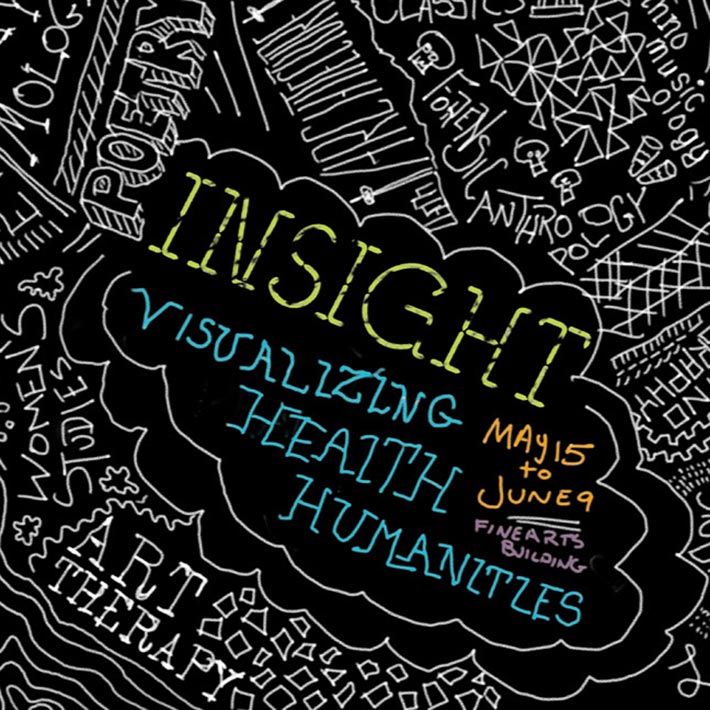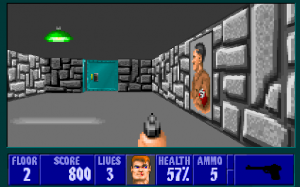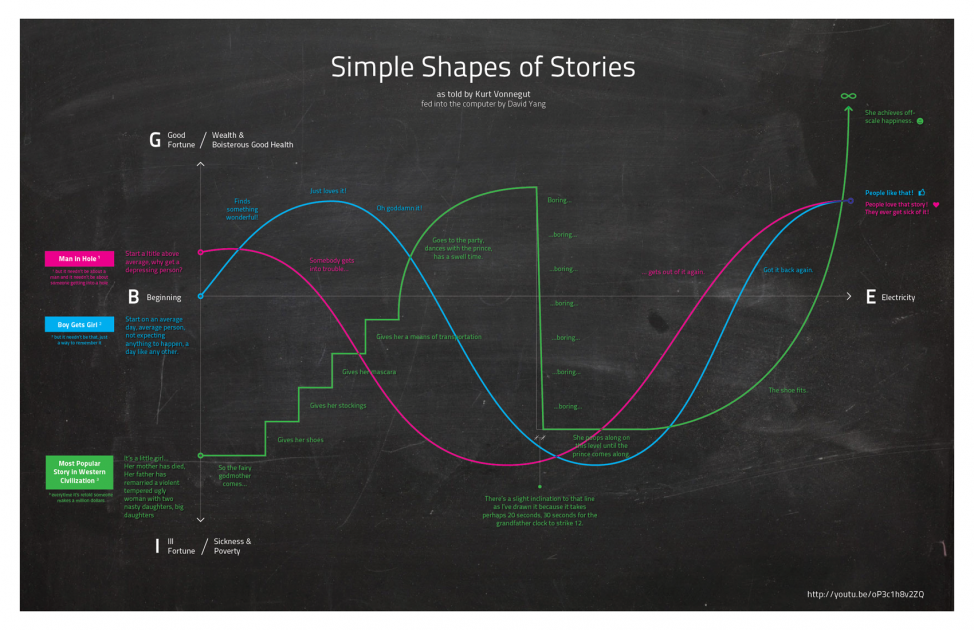The GRAND group has a work being exhibited at the InSight: Visualizing Health Humanities show that starts tonight. We used Unity to create a FPS (First Person Shooter) type of game for medical communication. The game, called CatHETR, lets players move through a ward dealing with communicative situations. This project was supported by the GRAND Network of Centres of Excellence.
Celebrating 20 Years of Wolfenstein 3D
From Slashdot a browser version of Wolfenstein 3D from Bethesda – Celebrating 20 Years of Wolfenstein 3D. You can play the game and choose levels (including secret ones.) There is a nice YouTube video with John Carmack, the director, talking about creating Wolfenstein.
Are gamers really sexist?
The Guardian has a nice short story by Keza MacDonald that asks Are gamers really sexist?. It doesn’t really answer the question or propose solutions, but it documents again how people who speak out against sexist language get harassed.
Perlin: Interactive Map of Pride and Prejudice
As I mentioned in my post on the GRAND conference, Ken Perlin showed a number of interesting Java apps that illustrated visual ideas. One was a Interactive Map of Pride and Prejudice. This interactive map is a rich prospect of the whole text which you can move around to see particular parts. You can search for words (or strings) and see where they appear in the text. You can select some text and it searches. The interface is simple and intuitive. You can see how Perlin talks about it in his blog. I also recommend you look at his other experiments.
GRAND 2012 Conference Report
Last week I was at the GRAND 2012 conference. GRAND (Graphics, Animation, and New Media) is a Networks of Centres of Excellence that brings together people across disciplines and across the country around gaming, new media and so on. You can see my GRAND 2012 conference notes here.
This year we had two of the best keynotes of any conference I have been to. Valerie Steeves talked about her research into parents and youth on the internet. The change in attitudes of both parents and youth to the internet between 2000 and today was dramatic. Ken Perlin was the closing keynote and he showed Java apps that he wrote as experiments. It made me want to learn to program in Java just to have as much fun as he was having.
The X Factor – Brainstorm – The Chronicle of Higher Education
From Humanist, a link to an article on online education, The X Factor (in the Brainstorm blog of the Chronicle of Higher Education. The post talks about how Harvard University has joined with MIT to create edX, an online education consortium. Harvard is now joining the MOOC (Massive Online Open Courses) bandwagon pioneered by some Stanford profs who opened their courses to thousands. The author, Kevin Carey, points out that edX won’t compete with MIT or Harvard, but with other online providers and with less prestigious institutions.
I worry we are going to see a lessening of educational diversity. I worry that the star quality of MIT, Harvard and Stanford will drive out less prestigious players leaving us with a small number of online courses. Fewer instructors for more people will mean more standardization of education and less diversity.
The New York Times has a Room for Debate on this, Got a Computer? Get a Degree with different reactions to the news. Most seem positive, but few feel that certificates for taking MOOCs are comparable to real course credit.
Kurt Vonnegut on the Shapes of Stories
I’ve been meaning to blog on the video circulating of Kurt Vonnegut talking about the Shape of Stories. He describes the curves followed by popular stories like “boy meets girl” and suggests computers could even understand such simple curves. In Lapham’s Quarterly you can read the text of this lecture with illustrations. See Kurt Vonnegut at the Blackboard. In this version he asks about the value of such systems, a question which could apply equally to computer generated visualization,
The question is, does this system I’ve devised help us in the evaluation of literature? Perhaps a real masterpiece cannot be crucified on a cross of this design. How about Hamlet?
He concludes that the system doesn’t work because the truth is ambiguous. We simply don’t know in complex works (like Hamlet) if news is good or bad. Good literature is open to interpretation.
But there’s a reason we recognize Hamlet as a masterpiece: it’s that Shakespeare told us the truth, and people so rarely tell us the truth in this rise and fall here [indicates blackboard]. The truth is, we know so little about life, we don’t really know what the good news is and what the bad news is.
Many have noticed this amusing play on visualization including an infographic on Visua.ly, Kurt Vonnegut on the Shapes of Stories:
Prism: Collaborative Interpretation
Prism is the coolest idea I have come across in a long time. Coming from the University of Virginia Scholar’s Lab, Prism is a collaborative interpretation environment. Someone comes up with categories like “Rhetoric”, “Orientalism” and “Social Darwinism” for a text like Notes on the State of Virginia. Then people (with accounts, which you can get freely) go through and mark passages. This creates overlapping interpretative markup of the sort you used to get with COCOA in TACT, but unlike TACT, many people can do the interpretation – it can be crowdsourced.
They are planning some visualizations of the results including what look like the types of visualizations that TACT gave where you can see words distributed over tagged areas.
Bethany Nowviskie explains the background to the project in this Scholar’s Lab post.
TED Ed: Flip this lesson!
Jeff sent me a link to the beta TED Ed site where you can see how they are turning TED videos (and other animations) into simple lessons that we can use. See TED-Ed: Lessons Worth Sharing. The idea is that an instructor can reuse (flip) a video with their own questions and commentary. You can also use the framework with YouTube videos. Neat.
Robo-Readers Used to Grade Test Essays
A nice story from the New York Times by Michael Winerip, Robo-Readers Used to Grade Test Essays (April 22, 2012) talks automated essay scoring software (AES). The story first reports a study from the University of Akron that showed that AES software is comparable to human graders (see A Win for the Robo-Readers by Steve Kolowich from Inside Higher Ed.) The NYT story goes then to report how Les Perelman, a director of writing at MIT, has shown how you can game AES tools. Among other things they don’t check facts or truth so you can write all sorts of outrageous things and still get a good score from AES. The story discusses some of the patterns that get good scores like lexical variety and long sentences. The story ends with the possibility that AES could be matched by essay writing software,
Two former students who are computer science majors told him (Perelman) that they could design an Android app to generate essays that would receive 6’s from e-Rater. He says the nice thing about that is that smartphones would be able to submit essays directly to computer graders, and humans wouldn’t have to get involved.
Particularly interesting is an essay Perelman wrote to show how poor essays can game the system. I wish I could say that I never saw writing like this and that therefore there was no danger of AES systems rewarding the poor writing found in real essays,
In today’s society, college is ambiguous. We need it to live, but we also need it to love. Moreover, without college most of the world’s learning would be egregious. College, however, has myriad costs. One of the most important issues facing the world is how to reduce college costs. Some have argued that college costs are due to the luxuries students now expect. Others have argued that the costs are a result of athletics. In reality, high college costs are the result of excessive pay for teaching assistants.



